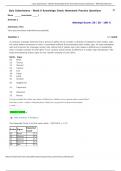Summary
Summary Molecular epidemiology of infectious diseases UA_2048FBDBMW_2324
- Module
- Institution
This document is a comprehensive summary of the course "Molecular Epidemiology of Infectious Diseases" by Prof. Jean-Claude Dujardin (). It includes detailed notes, PowerPoint slides, and corrected exercises from the lectures. Additionally, it contains a selection of exam questions, offering a thor...
[Show more]












